Table of Contents
Seeds are little vitamin bombs. At first glance, they are inconspicuous, yet they contain a load of beneficial nutrients. Whether it be chia seeds, pumpkin seeds or other varieties, they can all be easily added to your food to perfectly enrich your diet with valuable micronutrients. Which seeds should you definitively incorporate into your diet?
In this article you will learn about the benefits of these seeds:
What is it about these seeds that makes them so unique?
Seeds play a vital role in the plant world, as they are essential for reproduction. It is from seeds that a new plant develops. This makes them a great addition to your diet, thanks to their exceptionally varied nutrient content. You could compare them to an egg, for example, from which a chick develops. Like the egg, the seeds are a reservoir of countless beneficial substances necessary for the development of new life.
Whether we are talking about flax, sunflower or sesame seeds, they all have something in common. They are rich in healthy fats and many of them also have an interesting proportion of fibre or protein. They do not lack in vitamins, minerals or other beneficial biologically active substances. All these nutrients go hand in hand with health benefits that make them worth adding to your diet. In addition, the seeds are naturally gluten-free, so they can also be consumed by people with coeliac disease, gluten allergies or non-coeliac gluten sensitivity as part of a gluten-free diet.
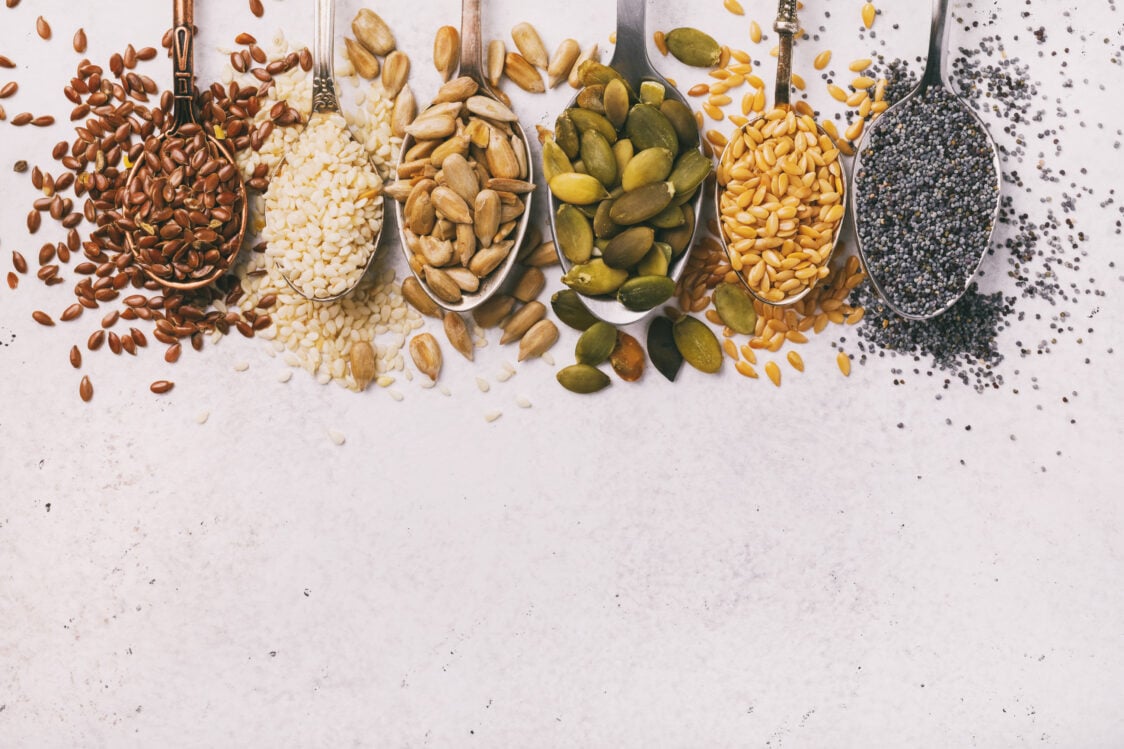
Which seeds are most nutritious and best?
1. Chia seeds
Chia seeds come from a plant called the Spanic sage, which is native to the regions of Mexico and Guatemala. These are tiny black balls that have been used by humans for nutrition and in cosmetics for more than 5,000 years. [11]
What health benefits do chia seeds have?
- They have been shown to have a beneficial effect on the cardiovascular system, mainly due to their content of healthy fats in the form of polyunsaturated fatty acids.
- They may also be involved in immune function.
- There is also talk of their effect on controlling inflammation in the body or, for example, blood clotting. The fatty acids contained in chia produce prostaglandins, leukotrienes and other substances involved in anti-inflammatory and coagulation processes.
- They can also be effective in lowering blood cholesterol levels.
- During pregnancy, they can be of benefit to the brain of the developing foetus.
- Your digestive system will appreciate them too. They can come in handy for problems with constipation or irritable bowel syndrome.
- They are also useful for weight loss, because thanks to their properties, they can help you feel fuller, thus helping to curb unpleasant hunger. [11]
What contains chia seeds?
Chia is valued for its great nutritional profile. They are rich in high quality protein, which also has a favourable spectrum of essential amino acids, which are those amino acids that our body cannot create on its own and must be consumed through diet. These are found in chia in near-optimal proportions not normally found in plant sources. [11]
Chia are also rich in fibre. You may be familiar with how these seeds swell when dipped in liquid. The water then binds to the fibre, which means that the seeds can increase their weight up to 15 times. This property is useful, for example, for proper digestion as well as for weight loss.
They also stand out for their healthy fat content. In fact, they are rich in beneficial polyunsaturated fats, specifically the well-known omega-3 monounsaturated fatty acid and alpha-linolenic acid (ALA). From this, the body produces eicosapentaenoic acid (EPA) and docosahexaenoic acid (DHA), which are essential for a healthy brain, eyesight and heart.
Chia seeds also contain various active substances such as polyphenols, including quercetin and chlorogenic acid. These and many other substances are known for their antioxidant properties, which help the body fight oxidative stress.
Among the minerals and vitamins, calcium, potassium, magnesium, folic acid and vitamin E are worth mentioning.
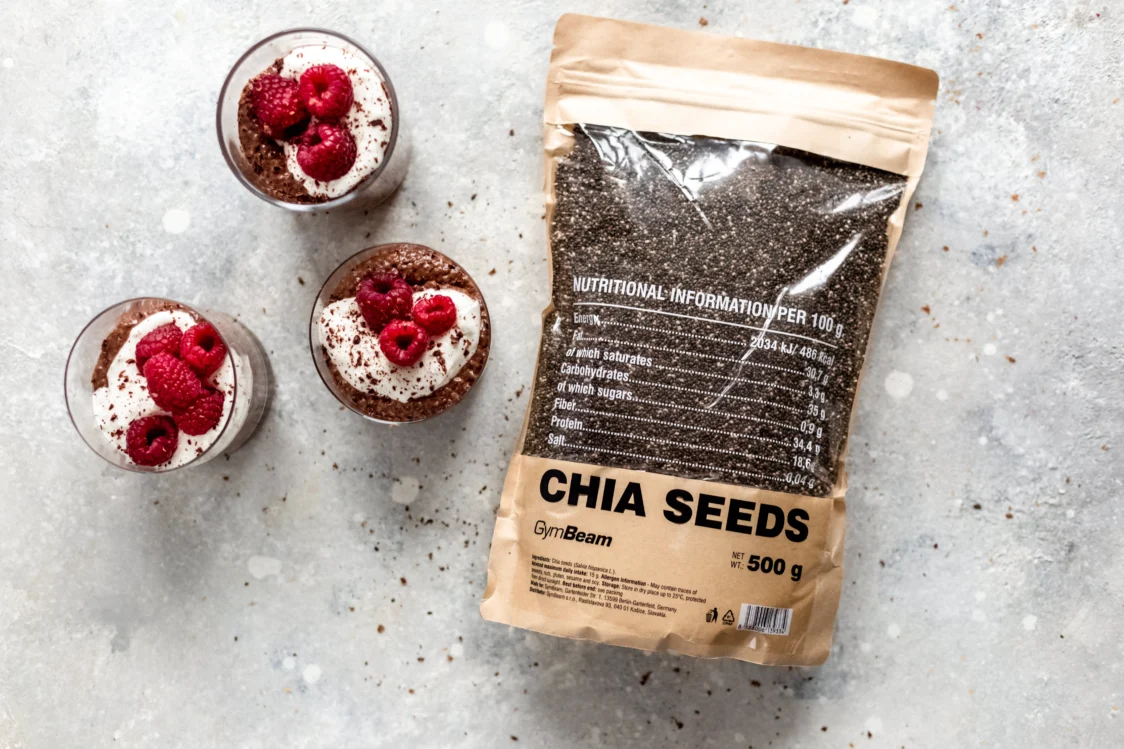
Average energy and nutrient content of chia seeds
Nutritional values | |
|---|---|
| Energy value | 486 kcal |
| Fat | 30.7 g |
| – monounsaturated fatty acids | 2.3 g |
| – polyunsaturated fatty acids | 23.7 g |
| Carbohydrates | 42 g |
| Fibre | 34.4 g |
| Protein | 16.5 g |
How to eat chia seeds?
You can add these tiny seeds to virtually any dish without changing its taste or flavour. For example, they are perfect for the following dishes.
- yoghurt with fruit
- cereal porridge
- cakes, muffins, biscuits
- muesli bars
- flapjacks, pancakes
- smoothie
The most well-known is the delicious chia pudding. It is prepared by soaking the seeds in yoghurt, water, milk or a vegetable drink and letting them swell. Then just garnish them with ingredients to taste.
You might be interested in these products:
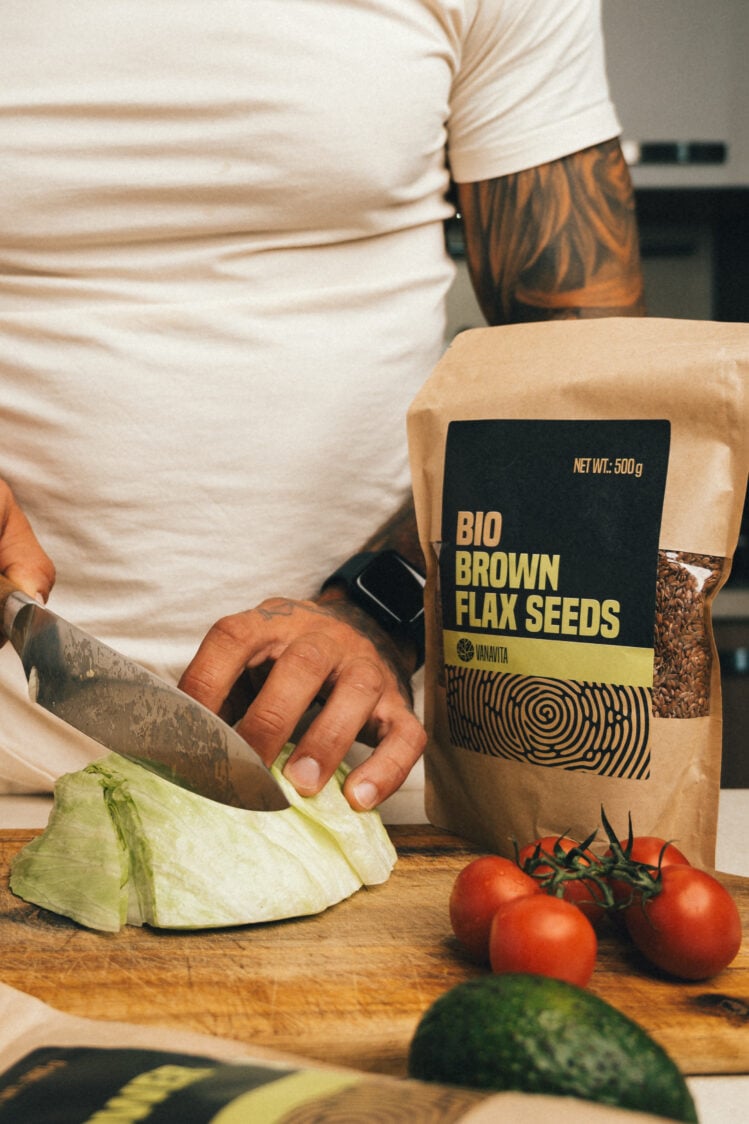
2. Flax seeds
Flax is a flowering plant with small purple-blue flowers from which yellow or brown seeds are obtained. It is currently cultivated in more than fifty countries, including India, China and Ethiopia. In fact, flax seeds are exceptionally nutritious and add extra value to food. [5]
Flax seed oil is also made from them. However, it is only suitable for cold cooking (e.g. as a salad dressing), as heat can destroy the beneficial substances it contains, which is certainly not what you want.
What are the health benefits of flax seeds?
- They boast a positive effect on cardiovascular health thanks to omega-3 fatty acids. For example, they have been shown to reduce LDL (bad) cholesterol and triacylglycerols in the blood.
- Their high fibre content is beneficial for those with diabetes. This is because it can help lower blood sugar (glycaemia).
- Studies suggest that they could also have a positive effect in efforts to prevent cancer. For example, they specifically address breast cancer.
- Their positive effect on digestion is also well known. They are often used to help relieve constipation.
- The brain can also benefit from flax seeds. [8]
What do flax seeds contain?
These seeds are one of the best plant sources of omega-3 fatty acids, which are particularly valued for their effects on the brain and heart. They are rich in the aforementioned alpha-linolenic acid (ALA), which accounts for up to around 70 % of the total fat content of the seeds. There are approximately 22 g of ALA in 100 g of seeds.
The EFSA (European Food Safety Authority) recommends that ALA should make up 0.5% of total energy intake. Thus, for a reference intake of 2000 kcal, 1 g of ALA per day would be sufficient. This is the amount found in 4.5 g of flax seed (approx. 1 teaspoon). [5,13]
Furthermore, flax seeds are rich in fibre, which consists of both soluble and insoluble components. On one hand, it can therefore be useful when we want to improve defecation, for example. However, in the digestive tract it can bind sugar, for example, and thus slow down its absorption. [5]
As far as micronutrients are concerned, these seeds have particularly high levels of potassium, zinc, magnesium, calcium and iron. They are also rich in folic acid. [5]
Flax seeds are characterised by their lignans, which, together with flavonoids and phenolic acids, are thought to contribute to the seeds’ antioxidant properties. They thus help the body to fight free radicals caused by oxidative stress. [5]
Average energy and nutrient content of flax seeds
Nutritional values | |
|---|---|
| Energy value | 534 kcal |
| Fat | 42 g |
| – monounsaturated fatty acids | 7.5 g |
| – polyunsaturated fatty acids | 28.7 g |
| Carbohydrates | 29 g |
| Fibre | 27 g |
| Protein | 19.3 g |
How to eat flax seeds?
You can eat them whole, but it is preferable to eat them ground. This way your body can absorb and use more nutrients from them. You can use the seeds in both forms to enhance, for example, the following dishes.
- cereal porridge, yoghurt or quark with fruit
- smoothie
- banana bread or other popular cakes
- crackers or various savoury snacks
- salads
Flax seeds (especially in ground form), like flaxseed oil, should be stored in the refrigerator. Because of their high omega-3 fatty acid content, they can oxidise and become rancid very quickly at room temperature or when exposed to light. They should not be consumed in this state.
Discover our bestsellers:
3. Sesame seeds
Sesame seeds come from the Indian sesame, a plant with white, bell-shaped flowers. It is one of the four main oilseed crops grown in China. Sesame seeds, which can be white, black, brown or red, are popular for their aromatic flavour and aroma, which is enhanced by roasting. They can also be enjoyed in the form of sesame oil or the popular tahini paste. [12]
What are the health benefits of sesame seeds?
- Scientists talk about their antioxidant effects, thanks to the content of many substances that have been shown to be able to effectively fight free radicals.
- Studies also highlight their effect on lowering cholesterol levels.
- Sesame seeds consumption has also been linked to lower blood pressure.
- They may also have anti-inflammatory effects. [12]
What do sesame seeds contain?
Sesame, like other seeds, are rich in healthy fats. They have roughly equal proportions of monounsaturated and polyunsaturated fatty acids. It is because of oleic acid, which is a MUFA, and other unsaturated FAs that sesame is beneficial for our heart and blood vessels. [12]
In the case of sesame seeds, it is also worth mentioning their essential amino acid content. These are found in optimal proportions and the quality of sesame protein is similar to that of animal protein. [12]
Of the minerals, iron, calcium and zinc are the most abundant. Of the vitamins, vitamin E, a well-known antioxidant, leads the way. Sesame seeds also contain other active substances which are worth mentioning. For example, sesamin, sesamol and other lignans, which have antioxidant properties. For instance, sesamin has also shown in studies to have a positive effect on blood pressure. [12]
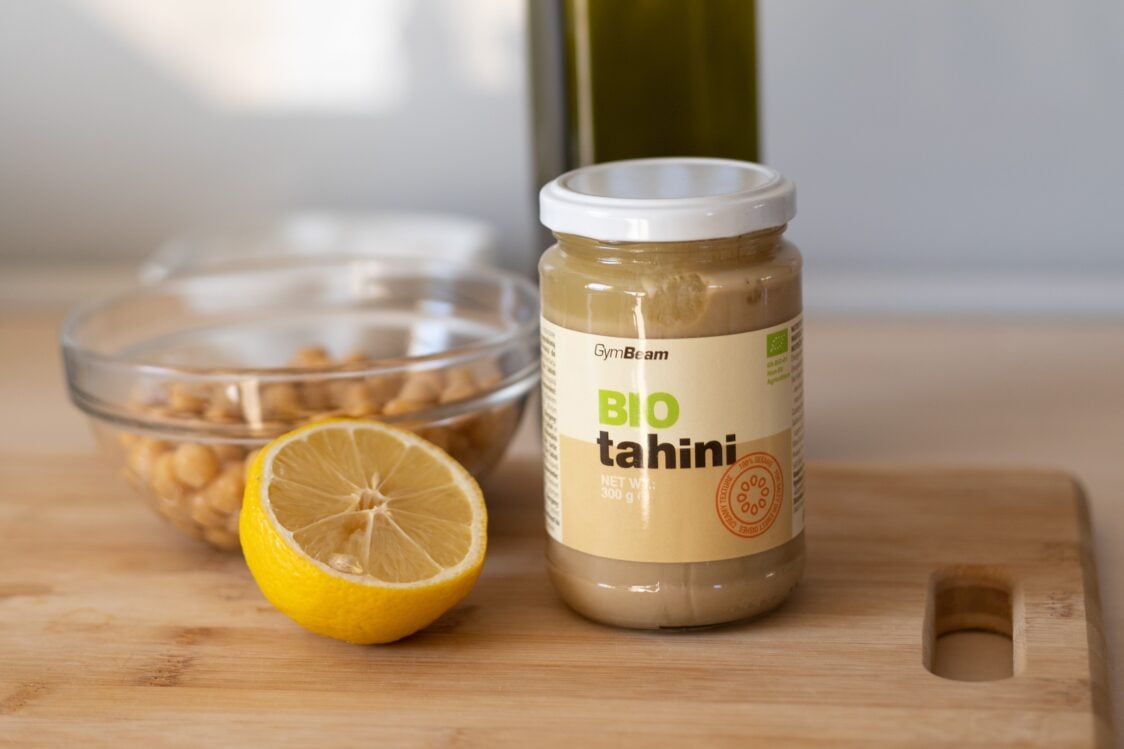
Average energy and nutrient content of sesame seeds
Nutritional values | |
|---|---|
| Energy value | 573 kcal |
| Fat | 49.7 g |
| – monounsaturated fatty acids | 18.8 g |
| – polyunsaturated fatty acids | 21.8 g |
| Carbohydrates | 23.4 g |
| Fibre | 11.8 g |
| Protein | 17.7 g |
How to eat sesame seeds?
Sesame is widely used in traditional Chinese dishes. Not only do they use sesame oil or tahini paste, but they also use the seeds to make sweets and cakes. You too can experiment with traditional or less traditional dishes and add sesame seeds to the following dishes, for example.
- salads
- soups
- savoury pastries
- savoury bars and other snacks
- biscuits
- crumbed meat crust
- meat sauces
4. Sunflower seeds
Sunflower seeds come from the beautiful and popular sunflower plant. This plant gets its name because of its sun-like appearance or its ability to rotate to follow the sun. It is a plant native to North America and was introduced to Europe by the Spanish in the 15th century. [10]
Sunflower oil is produced from sunflower seeds. It is available in a refined form, which is particularly suitable for warm cooking. However, there is also cold-pressed, which is more suitable for use in cold cooking.
What are the health benefits of sunflower seeds?
- Scientists have highlighted their antioxidant properties. They contain numerous antioxidants, such as sterols, tocopherols and other vitamins. [10]
- They can also help lower cholesterol, probably due to their phytosterol or unsaturated fatty acid content. [10]
- Overall, they can contribute to improved cardiovascular health. [1]
- They can be beneficial in osteoarthritis, rheumatoid arthritis or other inflammatory diseases. [1]
What do sunflower seeds contain?
Sunflower seeds are rich in protein and healthy fats. Of the fats, as in the case of the previous seeds, unsaturated fats lead the way. The most abundant fatty acids are oleic or linoleic acid, which are known for their positive health effects on the heart and blood vessels. [10]
The seeds also contain saturated stearic acid. Some types of sunflower oil even have up to 30% of this FA. You may know that some saturated fats, when consumed in excessive amounts, can have a rather negative effect on cardiovascular health. However, stearic acid in particular is known for its neutral effect. On the contrary, it makes the oil more stable and more suitable for heat treatment. [10]
Sunflower seeds are also rich in zinc, potassium, manganese, iron and selenium. Selenium is essential for the function of one of the most important antioxidant systems in the body, glutathione. The antioxidant properties of these seeds are also brought on by tocopherols (vitamin E) or carotenoids, for example. They also contain a significant proportion of folic acid and B vitamins. [10]
The phytosterol content of sunflower seeds is often mentioned. These play a positive role on the effect they have on cholesterol levels. They have a similar structure to cholesterol and are absorbed from the intestine instead. A daily intake of 0.4-2 g of phytosterols is recommended to show an effect on lowering LDL cholesterol. Sunflower seeds contain around 270 mg/100 g, so they will help significantly with your recommended intake. [9,10]

Average energy and nutrient content of sunflower seeds
Nutritional values | |
|---|---|
| Energy value | 584 kcal |
| Fat | 51.5 g |
| – monounsaturated fatty acids | 18.5 g |
| – polyunsaturated fatty acids | 23 g |
| Carbohydrates | 20 g |
| Fibre | 8.6 g |
| Protein | 20.8 g |
How to eat sunflower seeds?
You can enjoy them on their own as a tasty snack, or roast them, which gives them an interesting flavour and aroma. The seeds can also be used to spice up your favourite dishes.
- salads
- homemade muesli bars or granola
- soups
- spreads
- cakes, for example, banana cake
- cereal porridge
5. Pumpkin seeds
As the name implies, pumpkin seeds are obtained from the pumpkin. They are often seen as a waste product, which is a great pity as they are packed with health-enhancing nutrients.
Not only pumpkin seeds, but also the pumpkin seed oil produced from them is a nutritionally rich food with many benefits.
What are the health benefits of pumpkin seeds?
- Thanks to their composition, they have a positive effect on the health of the heart and blood vessels.
- They can help lower blood sugar levels, which can make them beneficial for diabetics.
- Studies also mention their possible antidepressant effect.
- They also show a promising positive effect on alleviating prostatic hyperplasia (benign enlargement of the prostate).
- They may also possibly have antimicrobial effects. [3]
What do pumpkin seeds contain?
Pumpkin seeds are also known for their healthy fat content. In terms of unsaturated fatty acids, omega-6 linoleic acid and monounsaturated oleic acid lead the way. The protein of pumpkin seeds excels in its essential amino acid content. In fact, their spectrum is similar to that of soya, which makes them a relatively high quality vegetable protein source.
These seeds are also rich in vitamin E, magnesium, potassium, phosphorus and zinc. They are also known for their relatively high iron content. However, it should be remembered that, as with other plant sources, this mineral is less easily absorbed than from animal foods. However, its absorption can be enhanced by combining it with vitamin C or animal protein.
Among other bioactive substances, they owe their beneficial effects to carotenoids, saonins, phenolic substances and phytosterols. [3]
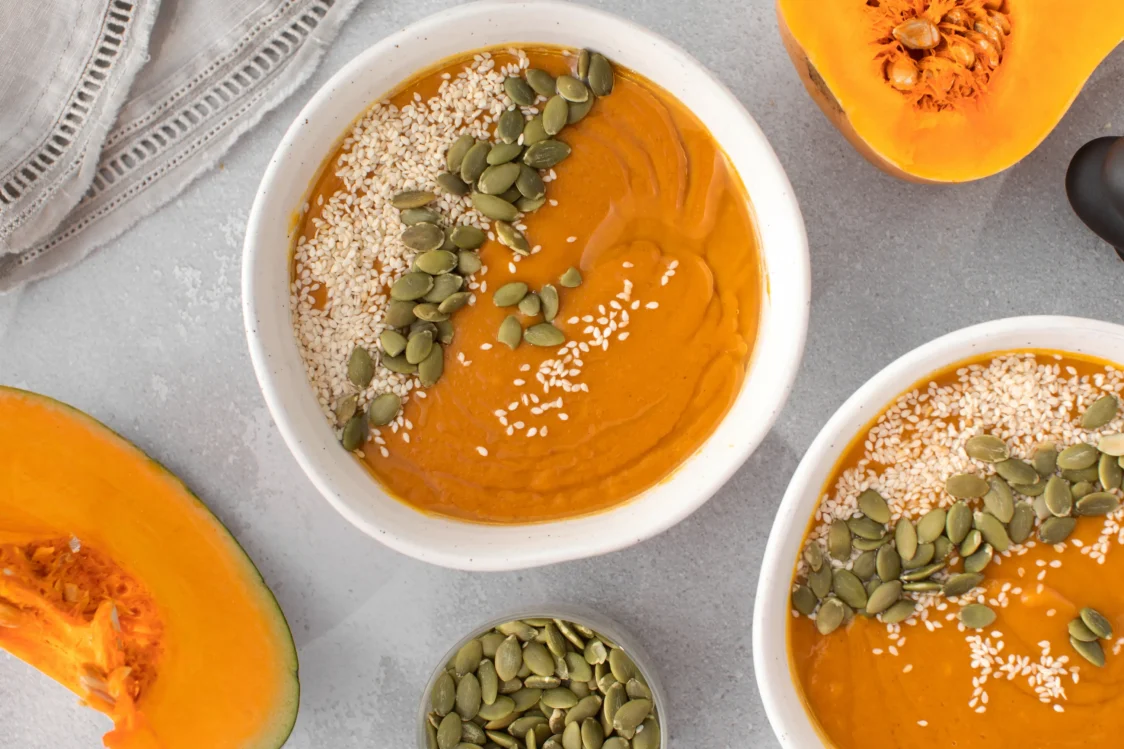
Average energy and nutrient content of pumpkin seeds
Nutritional values | |
|---|---|
| Energy value | 559 kcal |
| Fat | 49 g |
| – monounsaturated fatty acids | 16.2 g |
| – polyunsaturated fatty acids | 21 g |
| Carbohydrates | 10.7 g |
| Fibre | 6 g |
| Protein | 30.2 g |
How to eat pumpkin seeds?
In most cases, pumpkin seeds are eaten on their own, either in their natural form or roasted. However, like others, you can also add them to your favourite recipes.
- on a salad
- in soups
- in porridge
- in granola or muesli bars
- in pesto
- in home made baked goods, such as carrot bread
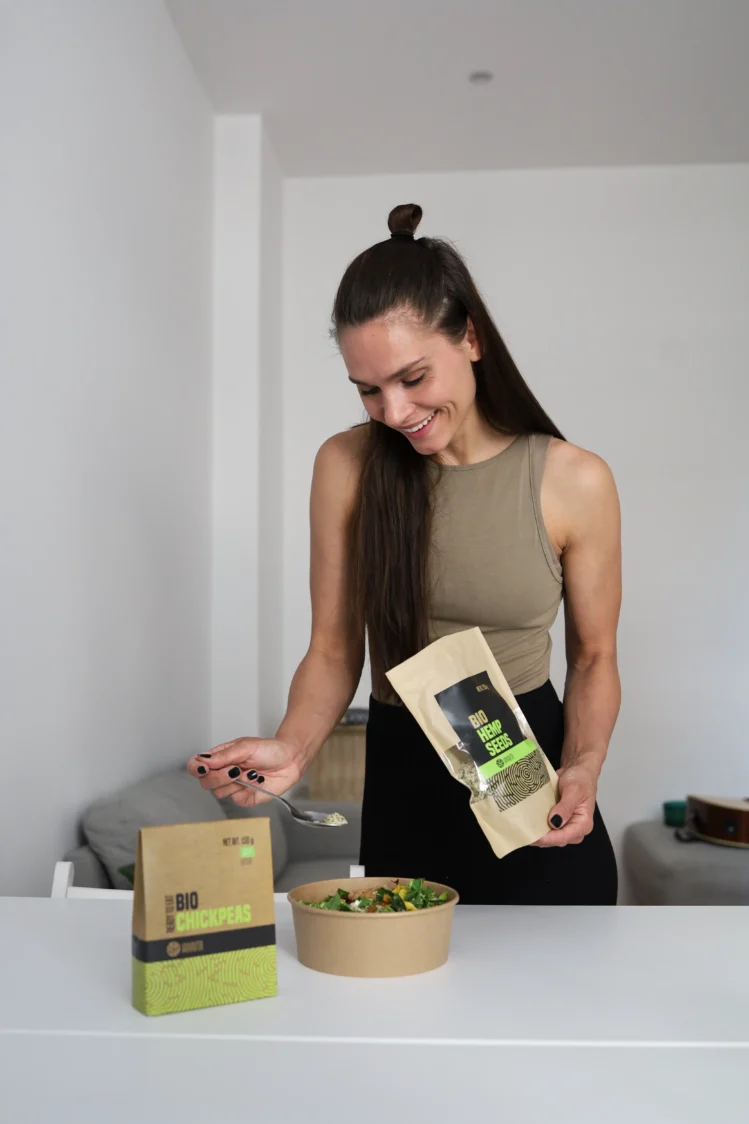
6. Hemp seeds
Hemp seeds come from the cannabis plant, so because of this fact they have long been overlooked. However, unlike other parts of the plant, they contain only negligible amounts of psychotropic substances. On the contrary, they boast many beneficial nutrients and health benefits. [4]
What are the health benefits of hemp seeds?
- They can help lower blood cholesterol and thus help prevent atherosclerosis.
- The cardiovascular system may also benefit from the abundant arginine, which is involved in the body’s production of nitric oxide. This helps dilate and relax blood vessels and lower blood pressure. [4]
- It also appears to have a positive effect on the skin. It can help relieve dryness or itching associated with eczema. [2]
- Studies also discuss their association with the alleviation of menopausal symptoms. [4]
What do hemp seeds contain?
Healthy fats make up the most important part of these seeds. These are mainly unsaturated fatty acids, most of which are PUFAs. The ratio of monounsaturated to polyunsaturated FAs is 3:1 to 5:1, which also represents the ideal ratio of these two types of FAs in the diet. Hemp seeds can thus help improve the representation of the beneficial fats in your diet. These seeds also boast a relatively high proportion of protein, which is also easily digestible. Hemp protein can thus be a great choice of plant protein for vegans. [4]
Hemp seeds are similarly rich in micronutrients. These include vitamin E, phosphorus, magnesium, calcium, zinc and copper. They are also rich in beneficial phytosterols.
Average energy and nutrient content of hemp seeds
Nutritional values | |
|---|---|
| Energy value | 553 kcal |
| Fat | 48.8 g |
| monounsaturated fatty acids | 5.4 g |
| polyunsaturated fatty acids | 27.5 g |
| Carbohydrates | 8.67 g |
| Fibre | 4 g |
| Protein | 31.6 g |
How to consume hemp seeds?
These unassuming seeds can be added to both sweet and savoury dishes. For example, try the following.
- for sprinkling on a creamy soup
- in crackers and biscuits
- on a salad
- for the production of hemp milk
- in sweet cakes, porridges or smoothies
7. Poppy seeds
The poppy has been in existence and cultivated since ancient times. It has been used not only in nutrition but also as a medicinal substance. It contains opium, which has analgesic (pain-relieving) properties. This liquid from the unripe poppy seeds also contains addictive substances. Poppy seeds, however, do not contain these ingredients and can therefore be safely consumed as part of a normal diet.
What are the health benefits of poppy seeds?
- They may be useful for heart health, thanks to their unsaturated fatty acid content.
- They may be helpful in the treatment of osteoporosis.
- Scientists also talk about their antioxidant and antimicrobial effects. [7]
What do poppy seeds contain?
Poppy seeds are rich in fibre and unsaturated fats. Of these, omega-6 fatty acids are the most abundant.
Of the micronutrients, manganese, zinc, copper and phosphorus are worth mentioning. You will also often read about poppy seeds in connection with their high calcium content. However, calcium is less easily absorbed than from animal sources (e.g. dairy products) due to its antinutritional content (e.g. phytic acid). This should be kept in mind especially when following a vegan diet. [6]

Average energy and nutrient content of poppy seeds
Nutritional values | |
|---|---|
| Energy value | 525 kcal |
| Fat | 41.6 g |
| – monounsaturated fatty acids | 6 g |
| – polyunsaturated fatty acids | 28.6 g |
| Carbohydrates | 28 g |
| Fibre | 19.5 g |
| Protein | 18 g |
How to eat poppy seeds?
You are most familiar with poppy seeds in connection with baking and sweet recipes. For example, they can be added to the following dishes.
- in your favourite cakes
- cheesecake
- in porridge
- in the production of poppy seed drinks, most notably poppy seed milk
- in poppy seed potato dumplings or, for example, steamed buns
What other seeds can diversify your diet?
The seeds that we have mentioned are the most commonly found in stores and typically added to food by many of you. However, there are many more that you may come across.
- Many commonly use quinoa seeds as a side dish, and yet it is the seed of a plant called Chenopodium quinoa. It is naturally a gluten-free pseudocereal.
- Cumin or fennel seeds are characterised by their distinctive aroma. In doing so, they contain substances that can be beneficial for digestive problems such as flatulence and abdominal bloating.
- Pomegranate seeds stand out for their distinctive sweet and sour taste and juiciness. They are packed with antioxidants, fibre and potassium.
- Apricot kernels also belong among seeds. You may have come across the fact that they contain what is known as vitamin B17, to which some attribute, for example, an anti-cancer effect. However, this effect has never been proven. On the contrary, it is worth being cautious. This ‘vitamin’ is in fact amygdalin, from which toxic hydrogen cyanide is formed in the body. Excessive doses can thus be poisonous. The EFSA states that a healthy adult can consume three kernels without exceeding the established safe dose. [15]
What are sprouting seeds?
There are many seeds that cannot be eaten raw, but sprouting makes them more digestible. This is because the antinutritional content is reduced. In addition, sprouting further increases the proportion of beneficial substances in the seed.
Which seeds can be sprouted at home?
- mustard seeds
- alfalfa
- radish seeds
- broccoli seeds
- arugula seeds and others
How to germinate seeds?
The process is very simple. First of all, buy or make a germination bowl or jar at home. It is then important to soak the seeds and keep them moist during germination. The seeds will then germinate in about two days. The exact procedure depends on which seeds and which germination method you choose.
How many seeds should you eat daily?
What portion is right for you depends on your goals and the current composition of your diet. However, assuming you eat a varied and balanced diet and just want to supplement your diet with healthy fats and other nutrients, treat yourself to around 30g of seeds a day. This portion is large enough to provide you with important nutrients, but at the same time it doesn’t contain too many calories.
You can also enjoy the seeds while losing weight when you are in a calorie deficit. However, it is especially important to control your portion size. Because seeds are quite calorie dense due to their high fat content, it’s easy to overdo it on portion size. Therefore, make sure that the portion of seeds is within your optimal daily energy intake. Our online energy and nutrient calculator will help you determine what your ideal calorie intake is.
What is the lesson?
These seeds are unassuming at first glance, but contain a surprisingly large amount of nutrients. First and foremost, they boast healthy fats, yet fibre, vitamins and other antioxidants are not lagging far behind. Whether you choose flax, chia, hemp, pumpkin or sesame seeds, you’re sure to improve your health. However, you’ll do best to rotate them and include them regularly in your diet. Only then will your body be able to reap the best benefits from their positive impact on your heart, brain, digestion and other areas of health. Now, which meal are you going to add them to today?
Did you like today’s article? If you found it interesting or learned something new, don’t forget to share it with your friends and family.
[1] ADELEKE, B.S. - BABALOLA, O.O. Oilseed crop sunflower (Helianthus annuus) as a source of food: Nutritional and health benefits. – https://www.ncbi.nlm.nih.gov/pmc/articles/PMC7500752/
[2] CERINO, P. et al. A Review of Hemp as Food and Nutritional Supplement. – https://www.ncbi.nlm.nih.gov/pmc/articles/PMC7891210/
[3] DOTTO, J.M. - CHACHA, J.S. The potential of pumpkin seeds as a functional food ingredient: A review. – https://www.sciencedirect.com/science/article/pii/S2468227620303136
[4] FARINON, B. et al. The Seed of Industrial Hemp (Cannabis sativa L.): Nutritional Quality and Potential Functionality for Human Health and Nutrition. – https://www.ncbi.nlm.nih.gov/pmc/articles/PMC7400098/
[5] KAJLA, P. et al. Flaxseed—a potential functional food source. – https://www.ncbi.nlm.nih.gov/pmc/articles/PMC4375225/
[6] MELO, D. et al. Nutritional and Chemical Characterization of Poppy Seeds, Cold-Pressed Oil, and Cake: Poppy Cake as a High-Fibre and High-Protein Ingredient for Novel Food Production. – https://www.ncbi.nlm.nih.gov/pmc/articles/PMC9562219/
[7] MUHAMMAD, A. et al. Review on physicochemical, medicinal and nutraceutical properties of poppy seeds: a potential functional food ingredient. – https://ffhdj.com/index.php/ffhd/article/view/836
[8] PARIKH, M. et al. Dietary Flaxseed as a Strategy for Improving Human Health. – https://www.ncbi.nlm.nih.gov/pmc/articles/PMC6567199/
[9] PHILLIPS, K.M. et al. Phytosterol composition of nuts and seeds commonly consumed in the United States. – https://pubmed.ncbi.nlm.nih.gov/16302759/
[10] RAUF, S. et al. The exploitation of sunflower (Helianthus annuus L.) seed and other parts for human nutrition, medicine and the industry. – https://www.degruyter.com/document/doi/10.1515/helia-2020-0019/html
[11] ULLAH, R. et al. Nutritional and therapeutic perspectives of Chia (Salvia hispanica L.): a review. – https://www.ncbi.nlm.nih.gov/pmc/articles/PMC4926888/
[12] WEI, P. et al. Sesame (Sesamum indicum L.): A Comprehensive Review of Nutritional Value, Phytochemical Composition, Health Benefits, Development of Food, and Industrial Applications. – https://www.ncbi.nlm.nih.gov/pmc/articles/PMC9573514/
[13] Dietary Reference Values | DRV Finder. – https://multimedia.efsa.europa.eu/drvs/index.htm
[14] FoodData Central. – https://fdc.nal.usda.gov/fdc-app.html#/food-details/173757/nutrients
[15] Apricot kernels pose risk of cyanide poisoning | EFSA. – https://www.efsa.europa.eu/en/press/news/160427


Add a comment